Happy New Year. How did we do in 2010, and what’s ahead for 2011? In 2010 the readers of this site made the most accurate predictions of any website or publication in the world. It’s freakishly amazing, actually. Here’s the story:
Each year I give you the opportunity to predict the future; you can read them on the 2010 Predictions page, where the group, on average, predicted that the Dow would close at 11,667. As it turned out, the Dow close for the year at 11,577.51, so your prediction was freakishly close to the actual number. Well done. Very well done.
The group also predicted that the price of gold would close at $1,418, and where did gold close?
$1,420.70
Holy crap, you guys are good.
Very good.
Freakishly good.
I doubt there was any investment newsletter anywhere on the planet that was accurate to within $3 of the closing price of gold. (With that record, I’m liable to double the subscription price this year……….)
The closest prediction on the Dow on December 31, 2010 was from ChrisC, who predicted 11,500. That was an excellent prediction, so ChrisC wins our admiration for the year. (My prediction was the lowest of anyone, at 8,000, so obviously I was much too pessimistic, significantly under-estimating the power of massive government stimulus).
As for the price of gold, the individual winner was none other than me. Yes, dear readers, filed under the category of “it’s better to be lucky than good”, JDH predicted a year end gold price of $1,450 per ounce, only $30 above the actual closing value. The rest of you were either much higher, or much lower, but, with the power of averaging, we came up with a prediction that was even better than my winning individual prediction. Well done group.
And that’s the point here: by listening to what others are saying, we can get close to a consensus, and after all, that’s what the market is; a consensus, so using the group’s brain is wise.
2011 Predictions
So, what’s ahead for 2011? Before I answer that question, here’s your chance to impress. Send me your predictions before the end of the day on Tuesday, January 4, 2011, and I’ll add them to the list; I’ll post them all next week, and we’ll see how close the group can get to the actual numbers. Since the group was bang-on for 2010, I assume that whatever you come up with will be similarly prescient for 2011, so we will all simply invest using those targets, and we’ll all get rich. Cool, eh?
Here’s what you need to send me:
Prediction #1: The closing level for the Dow on March 31, 2011, June 30, 2011, September 30, 2011, and December 31, 2011.
Prediction #2: The closing level for one ounce of gold, in U.S. dollars, on March 31, 2011, June 30, 2011, September 30, 2011, and December 31, 2011.
Prediction #3: Anything else you want. The price of silver or oil, your top stock picks, who will win the Super Bowl, whatever. It doesn’t count in our contest, but it will be recorded for all time, just for fun.
You can post your predictions on the 2011 Predictions Board on the Buy High Sell Higher Forum, or you can e-mail them to me at 2011 Predictions (this e-mail will only remain active until the end of the day on January 4, 2011).
First in with 2011 Predictions is yellowcaked; you can read them here: 2011 Yellowcaked Predictions.
So, what do I predict for 2011? That’s a very good question. First item up for consideration: do we expect inflation, or deflation?
Inflation is probably the obvious choice, since all governments have spent the last two years printing a gazzillion units of currency. That’s why gold (priced in dollars) appears to be increasing, and why the stock market, with very thin general investor participation, is also increasing. If we define inflation as the increase in the money supply, then obviously we will have inflation.
Anecdotal evidence would also suggest that consumers continue to buy, with Boxing Day very busy this year, both here in North America and in the U.K. and on-line. If people are buying, inflation is possible.
However, you could also easily argue that the money supply is not increasing. Just because the government prints, or creates, money, it doesn’t mean that new money is going into the hands of real people, to do real spending. If money is created, and that money is used by the Fed to buy their own Treasury Bonds in an effort to depress interest rates, no real people see any real money. Ergo, no inflation. If banks get that new money, and leave it on their balance sheets and don’t lend it, there is no multiplier effect of that new money, then the real money supply, in the hands of real people, is not increasing.
Do real people have more nominal money? It doesn’t appear so. In fact, it appears that we are in a deflationary environment, where people have less real money, and therefore the money supply in real terms is actually shrinking. Here’s the evidence:
- The new Congress says they will cut spending. I find that very hard to believe, but on the off chance that they actually do, that would mean less government spending, so less money in circulation.
- Local governments are in the same boat: they have no money, so local governments will also have to cut spending.
- Foreclosures were up in the U.S. again in the Third Quarter; obviously foreclosures depresses house prices, which is obviously not inflationary.
- Unemployment in the U.S. remains at very high levels; if people don’t have jobs, they don’t spend, which means they aren’t driving up prices.
- While stock market gains in 2010 helped reduced some pension deficits, it likely that pensions will be reduced in the future, as warned by New York Governor Paterson on his last day in office. If your pension gets cut, you spend less, not more.
If deflation does become apparent, how will the “average Joe” react? That’s an easy question to answer. If a house cost $200,000 two years ago, and costs $180,000 today, and if you think with deflation it will only cost $160,000 a year from now, would you buy a house today? Nope. When prices are declining, you delay purchases in the hopes that they will be less expensive in the future.
So, if you are planning on making a killing in real estate in the near future, good luck.
If you think the price of cars, or anything else, will be declining, you don’t buy them. If people aren’t buying cars, or whatever, the people who make them aren’t working. Companies aren’t making sales, so profits are down, and that ultimately means the stock market goes down.
That the stock market will drop is inevitable; the real question is “when”?
As we all know, the stock market peaked at around 380 at the end of August, 1929, and then “crashed” to 228 in November, 1929, for a drop of 40% in 11 weeks. The market then staged an impressive rally, getting back up to over 293 by April of 1930, 22 weeks later, a gain of over 28%. The final crushing bottom of below 42 was not reached until the beginning of July, 1932, 116 weeks later, and almost 70% below the peak.
The Dow did not see 380 again until 1954. Yup, 25 years from peak to peak. An entire generation with no gains to show for 25 years of investing.
Where are we now?
The Dow peaked just over 14,100 in October, 2007, and then “crashed” to below 6,600 in March, 2009, for a decline of 54% over a 74 week period.
So, this time around, the decline took longer, but was more severe.
The Dow has since rallied back to 11,577, recovering 77% of it’s loses over the last 95 weeks.
Is the recovery over, or will we see more gains in 2011? Well, as you observed from my inability to predict the Dow in 2010, I have no idea. If I had to guess, I would assume that Newton’s First Law of Motion will remain operative, and the object that is the market will remain in motion, until an outside force acts on it to change it’s motion.
However, an argument could be made that we are at a very important Fibonacci Retracement Level. (As you recall, Fibonacci theory assumes that when a market recovers, it will then retrace to pre-determined Fibonacci levels at 23.6%, 38,2%, 50%, and 61.8% of the previous high). (And yes, I do remember my commentary on July 17, 2010, Fibonacci Says Sell, that was not correct). Where are we now?
Assuming that the high, on the S&P 500, was 1,562 on October 12, 2007, and the subsequent low was 683 on March 6, 2009, a 61.8% retracement would be back up to the 1,226 level. The S&P 500 closed on December 31, 2010 at 1,257.64, a mere 32 points from that level. It’s possible that we are only slightly over that level, and therefore the risk of a correction is very large.
Of course, we are now over that level, so perhaps the risk of a correction has passed, and it’s onward and upward from here.
Interestingly, on December 6 the S&P 500 closed at 1,223, and then on the open on December 7 it gapped up to 1,232, blowing right through the 1,226 level (see the circle in the chart), and it hasn’t looked back since.
So, if you want my wild guess, I can only assume that the bear market rally will continue for a while yet, presumably due to government stimulus. But again, I really have no idea, so govern yourselves accordingly. Personally, I’m not holding any index puts or shorts at the moment, since I’m not going to bet against the market.
What about Gold in 2011?
Gold is another story completely. Here’s the 10 year chart:
Yup, you’re seeing it correctly. Gold has had 10 uninterrupted up years. So, again using Newton’s First Law as a market prediction tool, I would assume the trend line will continue to point up and to the right. Yes, a correction to the 1,200 or even 800 level is possible, but the trend remains upwards. How high upwards (Click on the chart to see a larger version)?
Well, if you simply draw the line upwards, you get to somewhere in the $1,700 range at the end of 2011. The gold price increased by about 30.6% this year, so a similar increase next year would put us at $1,856 at the end of 2011 (which is why it’s a good idea to use math, and not my simplistic line drawings).
Here are the closing prices of gold for the last ten years, with a projection for 2011:
|
Year
|
Close
|
Increase
|
| 2000 | 274.45 | |
| 2001 | 276.50 | 1% |
| 2002 | 347.20 | 26% |
| 2003 | 416.25 | 20% |
| 2004 | 435.60 | 5% |
| 2005 | 513.00 | 18% |
| 2006 | 632.00 | 23% |
| 2007 | 833.75 | 32% |
| 2008 | 869.75 | 4% |
| 2009 | 1,087.50 | 25% |
| 2010 | 1,420.70 | 30.6% |
| 2011 | 2,000.00 | 41% |
As the chart shows, gold had two big years in 2002 and 2003, then a slow year in 2004, then three good years (2005, 2006 and 2007), followed by the consolidation year of 2008. It’s therefore quite possible that 2009, 2010 and 2011 will be another set of three good years. The third year of the cycle, where it isn’t a consolidation year, such as happened in 2007, can easily be a bigger increase than the two previous years. It’s therefore entirely possible that we could see a 41% increase in 2011, putting gold at $2,000 an ounce by the end of 2011.
So, if you want a prediction, there it is.
I’ll post my detailed predictions early this week, but before I do I want each of you to have your shot at it, since the group is obviously much smarter than I am. I finished 2010 with a gain on my main portfolio of 14.5%. That beat the market, but obviously did not beat the increase in gold or silver. I was in cash for most of the year, to preserve capital, but in hindsight the correct answer was to be fully invested. You can read all of the gory details on my Portfolio Performance page.
Oh well, live and learn.
Thanks for reading, I look forward to seeing your predictions, and Happy New Year.
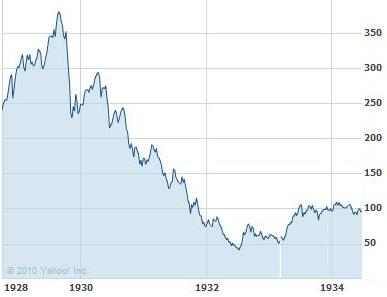
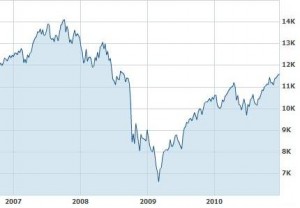
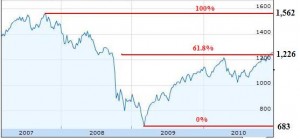
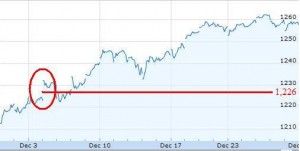

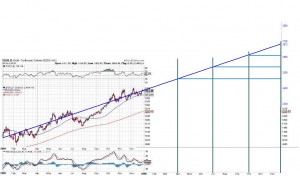
{ 0 comments… add one now }
You must log in to post a comment.